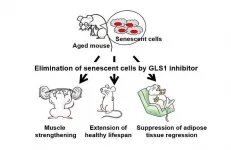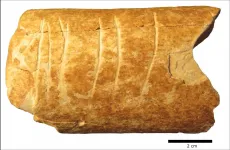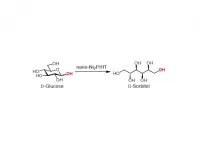(Press-News.org) Tuberous sclerosis complex (TSC) afflicts as many as two million people around the world, affecting multiple organs, including lungs, brain, skin and kidneys. In about 80 percent of cases, it causes cysts and benign tumors to form in the kidney, eventually resulting in kidney failure.
It's known that the disease is triggered by genetic mutations, but how these mutations lead to the formation of kidney cysts has been poorly understood - until now.
Nephrologist Manoocher Soleimani, MD, a professor in The University of New Mexico Department of Internal Medicine, led a team that solved the puzzle and pointed the way toward potential treatments for this devastating condition.
In a paper published this week in the Proceedings of the National Academy of Sciences, Soleimani and his colleagues report that unexpected changes in the composition and function of cells lining the collecting ducts that funnel fluid from kidney into the urinary tract are to blame.
"Kidneys form cysts in this disease, which continue to expand and get bigger and bigger and bigger," Soleimani says. "There is no good treatment."
A class of medications called mTOR inhibitors can shrink the cysts in about half of the patients treated, but the other half don't respond, he says. And if the treatments are discontinued, the cysts grow back, ultimately leading to kidney failure.
In exploring how mutations cause cysts to form and grow, Soleimani and colleagues at UNM, the Albuquerque Veterans Affairs Medical Center, Harvard University, the University of Cincinnati and the University of Tennessee focused on the two types of cells in the collecting ducts - principal cells and intercalated cells. In a healthy kidney, principal cells are responsible for fluid transport, while intercalated cells secrete acid.
Using a knockout strain of specially bred mice, Soleimani's team simulated the effects of the TSC gene mutation in the principal cells and examined the cysts that formed in the kidneys.
"We thought the cells lining the cysts would be principal," Soleimani says. "We were completely wrong! Ninety-five percent of the cells lining the cysts were comprised of intercalated cells. This was completely unexpected, and has never been reported."
Stranger still, as the cysts budded and grew into fluid-filled sacs, the genetically normal intercalated cells began behaving differently, excreting fluid, as well as acid. "They were genetically normal but functioning in an abnormal way," Soleimani says.
Looking more deeply into the problem, the team engineered double knock-out mice that lacked both the original cyst-driving mutation and a key gene driving the secretion of acid in the collecting ducts. "We found, to our pleasant surprise, that cyst size and numbers decreased by 85 to 90 percent in one double knock-out mouse model and were completely prevented in another double knock-out model," he says.
Zeroing in on the acid-secreting gene "opens new avenues" for potential treatments, Soleimani says, because existing FDA-approved medications are known to suppress its function.
Soleimani, who also provides clinical care at the VA Medical Center as well as UNM Hospital, recently received grant funding from the U.S. Department of Veterans Affairs for further research on kidney cysts in TSC.
"We are proposing to try to manipulate the activity of these molecules using medication," he says. "First we are going to do it in mice, but we are linking up with physicians that are taking care of TSC patients, and then we are going to move to try these medications in human beings."
INFORMATION:
Twitter has long provided a short, sharp take on the community's fears, anxieties and experiences. Now, data scientists have analysed 94 million tweets from the first months of the pandemic to track COVID-19's effect on mental health in NSW.
The research team used machine learning to develop a model able to capture data indicating depression, stress, anxiety and suicidal thoughts among users of the social media platform.
The aim was to tap into popular technology to help public health experts identify changes in community levels of depression over time.
The World Health Organisation highlighted early in 2020 that the pandemic would likely have a negative impact on mental health, with the disease affecting many facets of life including work, health and relationships.
Researchers from ...
Senescent cells accumulate in organs during aging, promote tissue dysfunction, and cause numerous aging-related diseases like cancer. The cells arise through a process called "cellular senescence," a permanent cell cycle arrest resulting from multiple stresses.
A collaborative research group led by Professor Makoto Nakanishi of the Institute of Medical Science, The University of Tokyo (IMSUT), and co-researchers has identified an inhibitor of the glutamate metabolic enzyme GLS1(*1) so that its administration selectively eliminates senescent cells in vivo. They confirmed that the GLS1 inhibitor eliminated senescent cells from various organs and tissues in aged mice, ameliorating age-associated tissue dysfunction and the symptoms of obese diabetes, arteriosclerosis, and ...
While scientists and historians have long surmised that etchings on stones and bones have been used as a form of symbolism dating back as early as the Middle Paleolithic period (250,000-45,000 BCE), findings to support that theory are extremely rare.
A recent discovery by archeologists from the Hebrew University and the University of Haifa alongside a team from the Le Centre National de la Recherche Scientifique in France have uncovered evidence of what may be the earliest-known use of symbols. The symbols were found on a bone fragment in the Ramle region in central ...
A City of Hope-led research team found that the same gene that increases the risk for Alzheimer's disease, ApoE4, can increase the susceptibility to and severity of COVID-19.
"Our study provides a causal link between the Alzheimer's disease risk factor ApoE4 and COVID-19 and explains why some (e.g., ApoE4 carriers) but not all COVID-19 patients exhibit neurological manifestations" said Yanhong Shi, Ph.D., director of the Division of Stem Cell Biology at City of Hope and co-corresponding author of the new study. "Understanding how risk factors for neurodegenerative diseases ...
The distinctive gut microbiome profile of a person with liver cancer linked to non-alcoholic fatty liver disease (NAFLD) could be the key to predicting someone's risk of developing the cancer, say researchers from the UNSW Microbiome Research Centre (MRC).
Their new study, published in Nature Communications recently, found the gut microbiome - the kingdom of microorganisms living in our digestive tracts - can modulate the immune response in liver cancer patients with NAFLD, in a way that promotes the cancer's survival.
While the research is still in its early stages, this finding could lead to more effective preventative and therapeutic treatments for people at risk of developing NAFLD-related liver ...
The intestine harbors the largest number of immune cells in our body. Since the intestine is constantly exposed to various antigens like bacteria and food, appropriate induction of gut immune cells plays a pivotal role in gut homeostasis.
A POSTECH research team - led by Professor Seung-Woo Lee, Ph.D. candidate Sookjin Moon and research assistant professor Yunji Park of the Department of Life Sciences - has uncovered for the first the mechanism for regulating the differentiation of T cells (intraepithelial lymphocyte, IEL) via intestinal epithelial cells (IEC). These findings were recently published in the Journal of Experimental Medicine ...
Cells replicate their genetic material and divide into two identical clones, perpetuating life -- until they don't. Some cells pause -- or are intentionally made to pause -- in the process. When the cell resumes division after such a pause, a displaced nucleus -- an essential part of cell survival -- can become caught in the fissure, splitting violently and killing both cells. But that is not always the case; some mutant cells can recover by pushing their nucleus to safety. Researchers from Hiroshima University in Japan are starting to understand how in the first step toward potential cell death rescue applications.
The results were published on Jan. 22 in iScience, a Cell Press journal.
The researchers examined fission yeast, a common model organism ...
This is the finding of an 18-year-study of over 300,000 people with diabetes in England, from scientists from Imperial College London and published in the journal The Lancet Diabetes & Endocrinology.
Thursday Feb 4th is World Cancer Day.
The research, funded by the Wellcome Trust, reveals that between 2001-2018 heart disease and stroke were no longer the leading causes of death among people with diabetes, as they were 18 years ago.
Diabetes affects 4.7 million people in the UK, and is caused by the body being unable to regulate blood sugar levels. Around 90 per cent have type ...
Osaka - Many different catalysts that promote the conversion of glucose to sorbitol have been studied; however, most offer certain properties while requiring compromises on others. Now, researchers from Osaka University have reported a hydrotalcite-supported nickel phosphide nanoparticle catalyst (nano-Ni2P/HT) that ticks all the boxes. Their findings are published in Green Chemistry.
Sorbitol is a versatile molecule that is widely used in the food, cosmetics, and pharmaceuticals industries. There is therefore a pressing need to produce sorbitol in a sustainable, low-cost, and green manner.
The nickel catalysts that are commonly used in the industrial hydrogenation of glucose to sorbitol are unstable in air and require hash reaction conditions. Rare metal alternatives--despite being ...
Remember the first rule of fight club? That's right: You don't talk about fight club. Luckily, the rules of Hollywood don't apply to science. In new published research, University of Arizona researchers report what they learned when they started their own "fight club" - an exclusive version where only insects qualify as members, with a mission to shed light on the evolution of weapons in the animal kingdom.
In many animal species, fighting is a common occurrence. Individuals may fight over food, shelter or territory, but especially common are fights between males over access to females for mating. Many of the most striking and unusual features of animals are associated with these mating-related fights, including the horns of beetles and the antlers of deer. What is less clear ...




